The present progressive in Spanish is a very important grammatical structure, just like its English counterpart. In this lesson, we will learn the basic rules to talk about actions in progress in Spanish through several examples and interactive quizzes. Let’s start…
The basic structure for the present progressive in Spanish
As we mentioned above, the present progressive tense in Spanish is generally used to talk about actions in progress, that is, things you or someone else are doing at the moment of speaking. Unlike sentences such as “Yo limpio la casa” (present tense), which are more appropriate for daily routines, sentences with the present progressive in Spanish will make use of the verb ESTAR and an additional verb in gerund form (gerundio), as shown in the picture below:
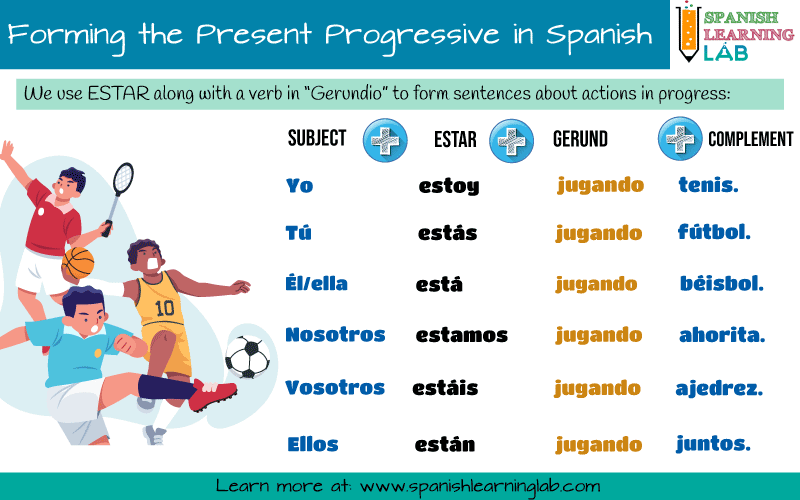
In general, the verb ESTAR will be conjugated differently for each subject pronoun, but the gerund form of the verb will stay the same for all of them, just as we did in the examples in the picture above. We have covered the irregular verb ESTAR in a previous lesson, so please take some time to check that one if needed. Here are three more sentences with the verbs LAVAR, BARRER and ARREGLAR following the basic structure for sentences in the present progressive in Spanish:
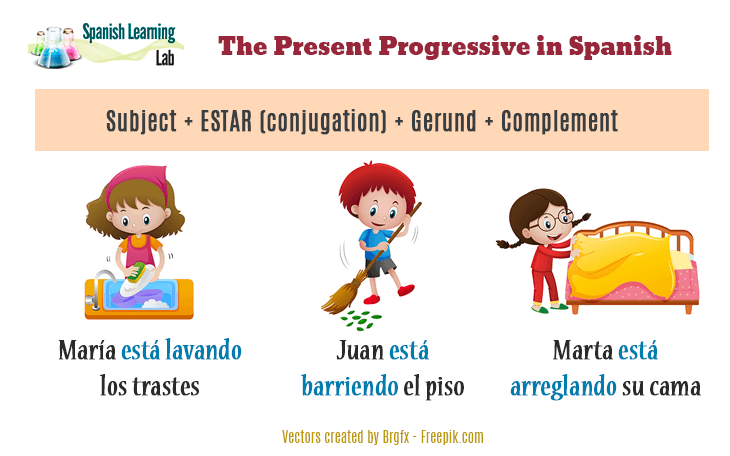
Again, keep in mind that if we want to make a similar sentence with a different subject, all we need to do is change the form of ESTAR, for example:
- Yo estoy lavando los trastes. (I am washing the dishes)
- Nosotros estamos barriendo. (We are sweeping.)
- Vosotros estáis arreglando vuestras camas. (You are making your beds.)
Remember that the verbs LAVANDO and BARRIENDO, which are the main verb in the sentences, will keep the same gerund form for all pronouns.
Gerunds and the present progressive in Spanish: rules and examples
It is time to get into more details about the rules for the gerund in Spanish. We will mention each of the rules and will also show you some examples of sentences using the progressive tense in Spanish. The verb’s ending in infinitive will tell us how to form its gerund form, just as we illustrated with the verbs ESTUDIAR, COMER and ABRIR in this picture:
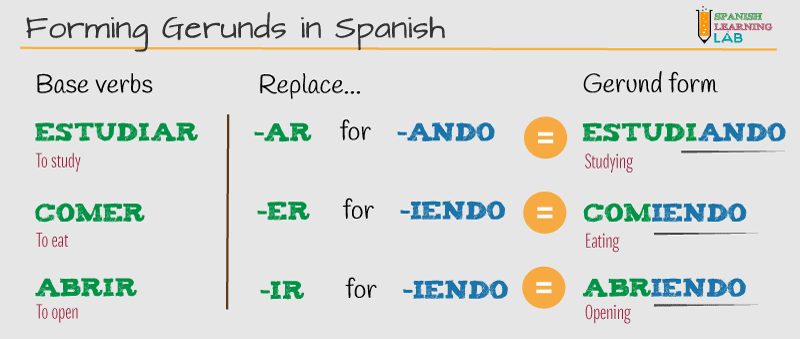
Next, we will show you more examples on how the ending of each verb should change depending on its original form in infinitive.
Spanish verbs ending in –AR
When verbs end in –AR, we must replace –AR for –ANDO. Here are some examples:
|
JUGAR – Yo estoy jugando.
Play – I am playing
|
|
HABLAR – Ella está hablando
Speak – She is speaking.
|
|
Pensar – Nosotros estamos pensando.
To think –We are thinking.
|
Spanish verbs ending in –ER and –IR
The gerund form of –ER and –IR ending verbs in Spanish will be the same. Both of them will change to –IENDO. Here are some examples
|
COMER – Él está comiendo.
To eat – He is eating.
|
|
HACER – Los niños están haciendo la tarea.
To do – The children are doing their homework.
|
|
VIVIR – Estoy viviendo en otra ciudad.
To live – I am living in another city.
|
|
ABRIR – Vos estás abriendo los regalos.
To open – You are opening the gifts.
|
Stem-changing verbs and the present progressive in Spanish
Stem-changing verbs are a special type of verbs which, besides changing their ending, will suffer a change in their stem. For instance, the verb “DORMIR” will be normally conjugated as “Yo duermo”, “Tú duermes” and so on for the present tense instead of “Yo dormo” or “Tú dormes”. Similarly, the verb’s stem will change a bit for the present progressive tense in Spanish, so we will say “Yo estoy durmiendo”, “Tú estás durmiendo” and so on. Here is a list of verbs with irregular gerund forms in Spanish:
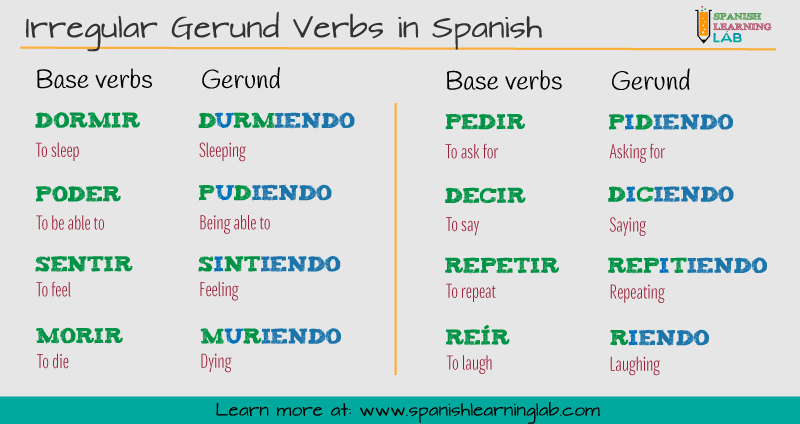
Check the following group examples of sentences using some irregular gerund forms in Spanish:
|
SERVIR – Yo estoy sirviendo la cena.
To serve – I am serving dinner
|
|
PEDIR – El mendigo está pidiendo en la calle.
To ask for – The beggar is begging on the street
|
|
DECIR – Te estoy diciendo que no es así.
SAY – I’m telling you it’s not like that.
|
|
MORIR – Estoy muriendo de sueño.
To die – I’m dying to go to sleep
|
Spelling changes and the present progressive in Spanish
Sometimes, the gerund form of verbs in Spanish will require a spelling change. That is the case for common verbs such as IR and LEER. IR will totally change to “YENDO”, whereas “LEER” will change to “LEYENDO”.
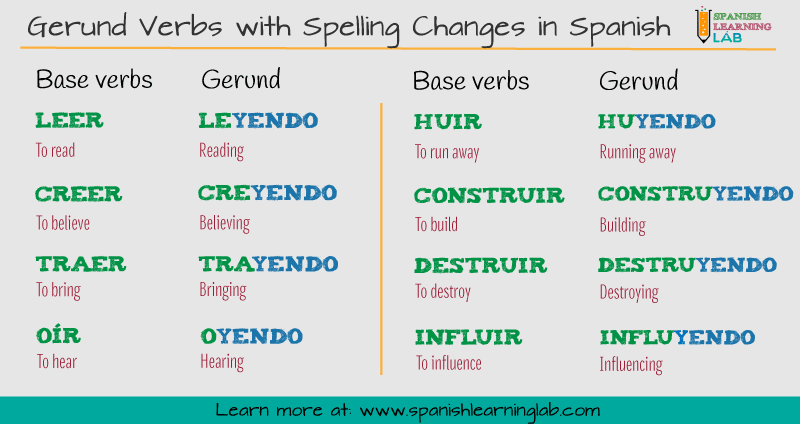
Listen to this group of sentences in the Spanish present progressive tense, making use of some spelling changing verbs in gerund form:
|
CAER – Está cayendo nieve en las montañas.
To fall – Snow is falling in the mountains.
|
|
OIR – Estamos oyendo el partido.
To hear/To listen – We are listening to the game.
|
|
LEER – ¿Qué estás leyendo? – Estoy leyendo un libro de misterio.
To read – What are you reading? – I’m reading a mystery book.
|
Sample conversation using the present progressive in Spanish
Before you test yourself with the grammar quiz in this lesson, take a look at the following short conversation using the present progressive tense in Spanish. It includes some of the verbs that we presented before, as well as some new expressions.
- Alan: ¿Qué estás haciendo Carlos?
- Carlos: Estoy estudiando para el examen. ¿Y tú?
- Alan: Estoy viendo una película ¿Para qué examen estás estudiando?
- Carlos: Para el examen de español. Estoy leyendo un libro llamado “Don Quijote”
- Alan: ¿En serio? ¿Es bueno?
- Carlos: Sí, es bueno. También estoy haciendo tareas de otras clases.
- Alan: Sigue estudiando. Nos vemos mañana.
- Carlos: Hasta mañana entonces.
Interactive quiz: The rules for the Spanish present progressive
Related Spanish Worksheets:
- Verbs and Actions in Progress in Spanish – PDF Worksheet
- The Present Progressive in Spanish – PDF Worksheet
- Common Actions in Spanish – PDF Worksheet
